Smart home tech has come a long way. What used to feel like a parade of flashy gadgets now actually helps with the daily grind. From voice-controlled speakers to automated security, these devices are reshaping how we live at home.
Remember to repin your favorite images!
Pick the right smart home features and you’ll save time, boost security, and even cut down on energy bills—all while making your routines a little smoother.
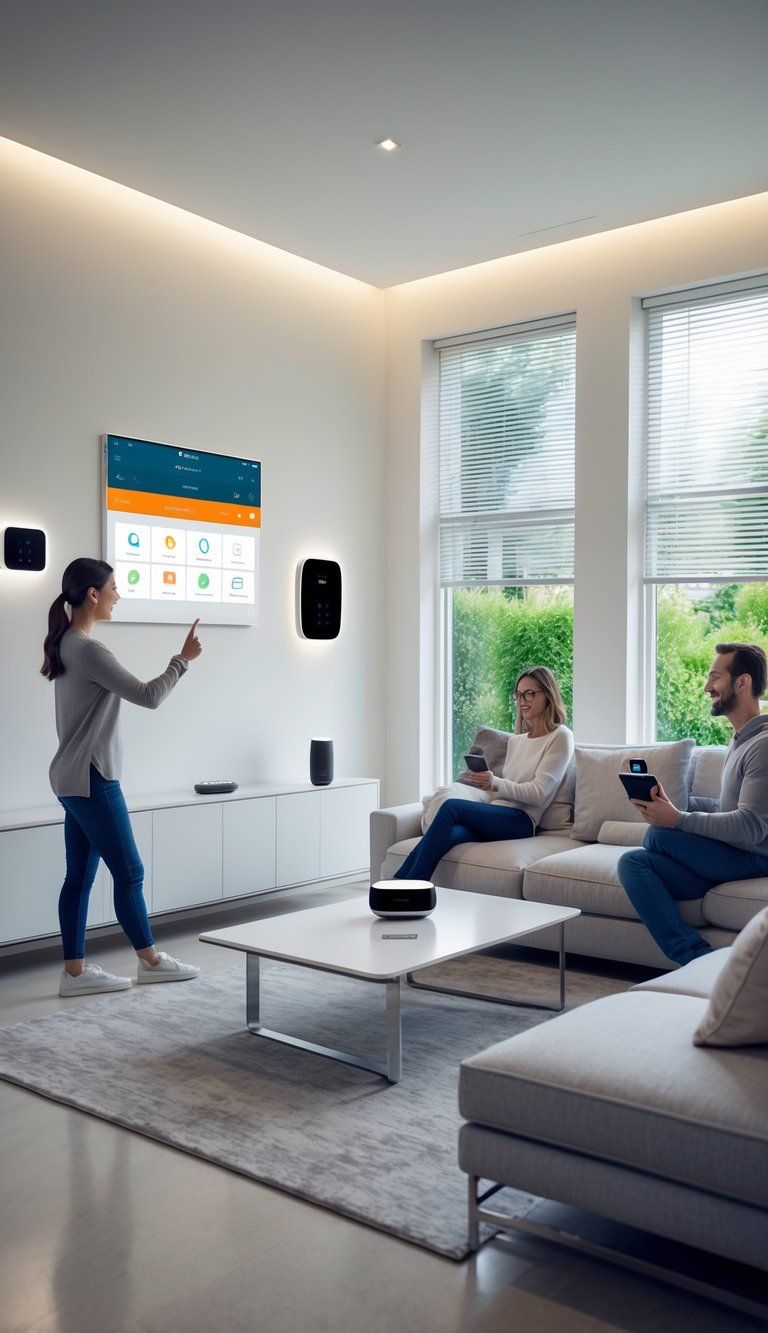
The smart home market is on track to hit nearly $150 billion by the end of the year. That’s massive, and it shows just how much these tools matter now.
But with so many options, which ones actually work as promised? Smart speakers like Amazon Echo or Google Nest often become the main hub, letting you control everything else with your voice.
Not every smart upgrade is worth the hype, though. The best ones solve real problems instead of just adding more tech for the sake of it.
Smart security systems, like video doorbells and smart locks, let you keep an eye on your home no matter where you are. Automated lighting, smart thermostats, and gadgets that simplify your morning or night routine also belong on the must-have list.
Centralized Smart Home Control
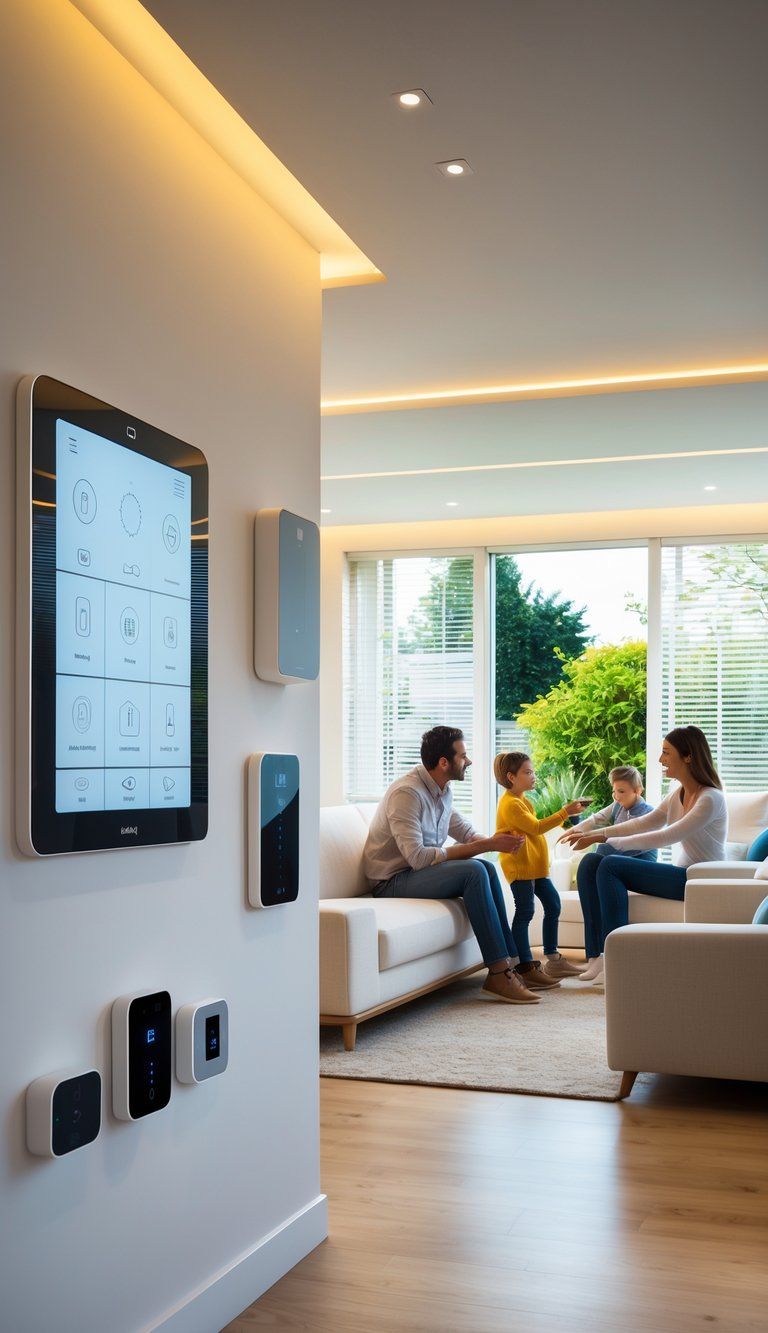
A central hub system pulls all your smart devices together, making everything easier to manage. You end up with less confusion and more control over your home’s tech.
Voice Assistants: Amazon Alexa and Google Assistant
Voice assistants have changed the way we interact with our homes. With Alexa or Google Assistant, you can turn on lights, tweak the thermostat, or lock the door—just by asking.
Saying, “Alexa, turn off the living room lights,” or, “Hey Google, set the temperature to 72 degrees,” means you don’t have to stop what you’re doing. It’s a lifesaver when your hands are full or you’re already cozy on the couch.
Both assistants work with thousands of devices from different brands. You can even set up routines—say “Good morning” and suddenly your coffee maker starts, the blinds go up, and your favorite podcast starts playing.
App-Based Management
Smart home apps put control right in your pocket. Most hub systems have a central app that lets you monitor and adjust all your connected gadgets.
You can check on your home from anywhere. Forgot to turn off the lights at work? No problem—just tap your phone. Want the house warm before you get home? You can do that, too.
Many apps show you energy use and patterns so you can make smarter choices.
Key features you’ll want in a smart home app:
- Device grouping – Tweak multiple things at once
- Scheduling – Set times for devices to turn on or off
- Scene creation – Save settings for different moods or activities
- User permissions – Give your family the right access
Integration With Third-Party Services
The real magic happens when your smart home connects with other services. Modern hubs can do more than just control devices—they talk to outside platforms.
Weather services can tell your sprinklers to skip watering if rain is coming. Security systems can flash lights if an alarm gets triggered. Your entertainment system can dim the lights and lower blinds when you start a movie.
IFTTT (If This Then That) lets you link up services that wouldn’t normally talk to each other. You can set up custom automations—like having your porch light turn on when your pizza delivery is close.
The more your smart home can connect to other services, the more flexible and helpful it becomes.
Smart Thermostats and Energy Efficiency

Smart thermostats are actually one of the best upgrades you can make. They keep you comfortable and save you money on energy—sometimes cutting heating and cooling costs by about 8% a year.
These gadgets also make climate control a breeze.
Optimized Scheduling
Smart thermostats let you set up custom heating and cooling schedules. You can program cooler temps for sleep, warmer settings when you’re up, and energy-saving modes for when you’re out.
Most models let you set different schedules for weekdays and weekends. That way, your home stays comfy when you need it, but you’re not wasting energy when you don’t.
You can adjust schedules from anywhere using the app. Heading home early? Just warm things up before you arrive.
Energy-Saving Tip: Drop your thermostat 7-10 degrees for 8 hours a day (like when you’re at work or asleep) and you might cut your heating bill by up to 10%.
Real-Time Energy Consumption Monitoring
Modern smart thermostats show you exactly how much energy you’re using. You get daily, weekly, and monthly reports that reveal when your system runs the most.
These reports help you spot peak times and odd usage patterns. Some systems even show how your energy use stacks up against previous months or similar homes.
A few models estimate your energy costs and suggest ways to cut down. With this data, you can make smarter choices—maybe you’ll spot times when the system runs for no good reason and tweak your schedule.
Automated Adjustment and Learning
Smart thermostats learn your habits over time. After you install one, it watches when you adjust the temp and starts picking up on your patterns.
Some models use motion sensors to see if you’re home and adjust temps for comfort or savings. Others use geofencing, tracking your phone’s location to know when to switch settings.
Weather-aware models pull in forecasts and prep your home for changes—so if a cold front’s coming, your system gets ready on its own.
The more you use these thermostats, the better they get at keeping you comfortable while saving energy.
Enhanced Home Security Features
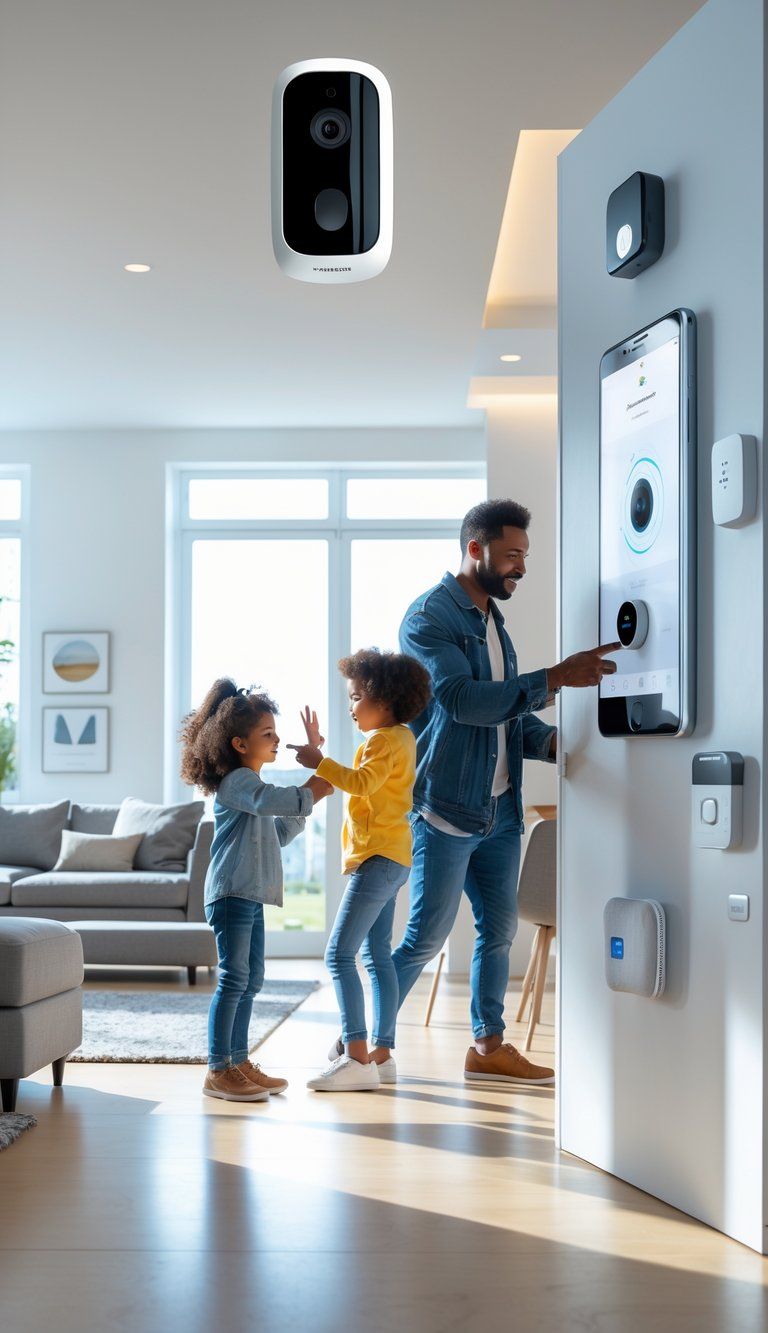
Smart home tech has totally changed how we protect our homes and families. Security features today feel way more user-friendly and effective than old-school systems.
Intelligent Security Systems
Smart security systems connect different devices to create a safety net around your house. You can control everything from your phone, and most systems don’t even need pro installation.
Most setups come with door and window sensors, motion detectors, and a central hub to keep things organized. If something trips a sensor, you get an instant alert on your phone.
You can choose professional monitoring and pay month-to-month, no long contracts needed.
The best systems also work with your other smart devices. Your lights can turn on if motion gets detected, or cameras can start recording when a door opens.
Smart Locks and Door Access Control
Smart locks have changed the way we come and go. You can unlock your door with your phone, a code, or even your fingerprint.
These locks let you set up temporary codes for visitors or service folks. Need to let the dog walker in? Just make a code that works at certain times.
Most smart locks track who comes and goes, so you’ll always know when your kids get home or when the cleaners arrive.
Many locks will auto-lock if you forget. Some even unlock as you approach, phone in pocket.
Battery life is better now—most last 6-12 months before you need to swap them out.
Video Doorbells for Remote Monitoring
Video doorbells let you see who’s at your door from anywhere. When someone rings, you can see and talk to them right from your phone.
They record motion-triggered clips, so you can keep tabs on packages or unexpected visitors. Most store video in the cloud for later.
Video doorbells now offer HD video and night vision. Some premium models use person detection, so you’re not getting pinged every time a car drives by.
Two-way audio lets you chat with visitors even if you’re not home, making it look like someone’s always there.
A few models connect with smart locks, so you can let trusted folks in remotely.
Motion-Detected Alerts
Motion sensors form the backbone of a good smart security setup. These little devices spot movement in and around your house and send you alerts right away.
Modern motion sensors are smart enough to ignore pets and reduce false alarms.
Place them near entry points—doors, windows, hallways. One sensor in a main hallway can keep an eye on several rooms.
Motion sensors can trigger other devices, too. Lights can pop on if motion is detected at night, which might scare off would-be intruders.
Some systems use AI to learn your household’s patterns. They’ll only ping you when something’s out of the ordinary, so you don’t get overwhelmed by alerts.
Smart Lighting Solutions
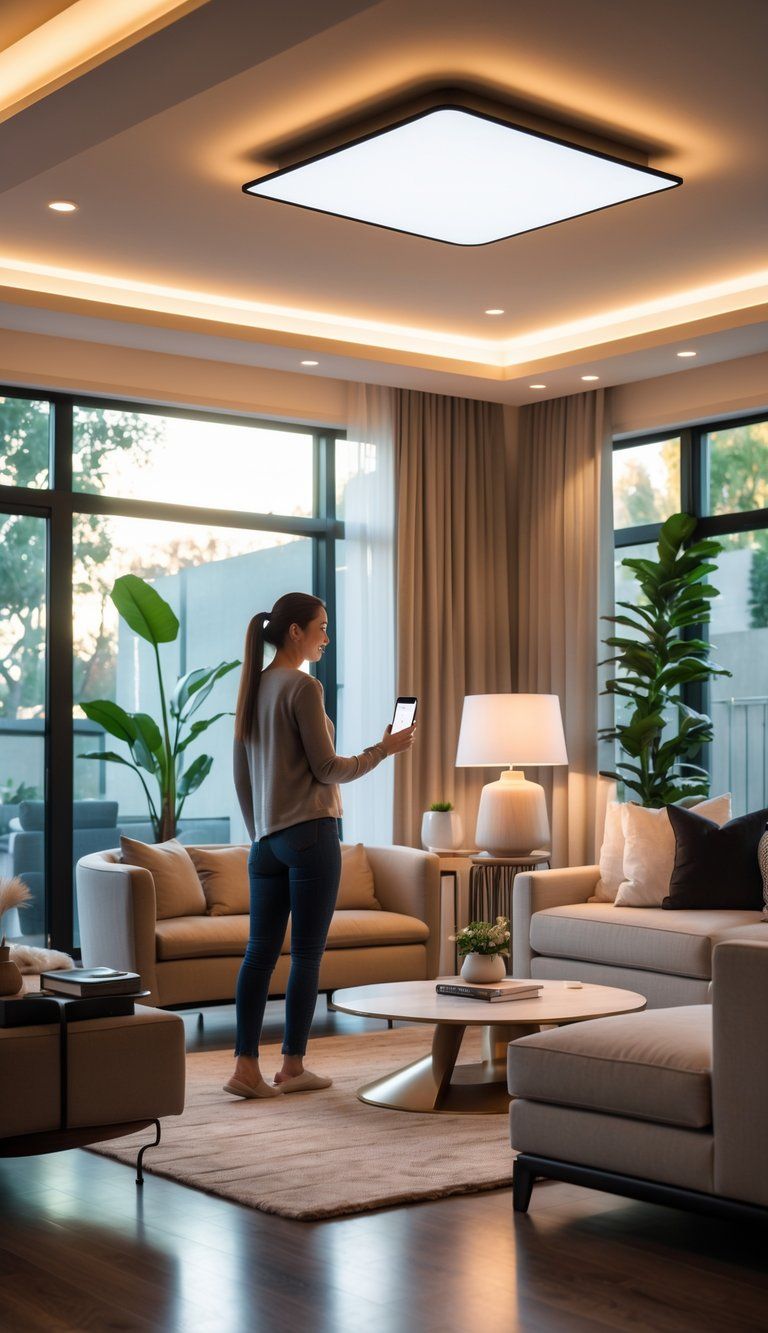
Smart lighting is one of those home upgrades that really pays off. It does way more than just turn lights on and off—these systems transform your living space, help you save energy, and add a layer of security.
Personalized Lighting Scenes
With smart lighting, you can create custom scenes for different moods or activities. Set a “Movie Night” scene that dims the living room to 30% and shuts off the hallway lights. Or try a “Wake Up” scene that slowly brightens your bedroom like a sunrise.
Most systems let you save these scenes in their apps. You can turn them on with a tap or a quick voice command—”Alexa, turn on Dinner Mode.”
Mixing and matching fixtures in a scene is where it gets fun. Your kitchen can go from bright for cooking to cozy for dinner in seconds.
Automated Schedules and Sensors
Smart lighting shines brightest when it’s automated. Set schedules so lights turn on at sunset and off at bedtime—no more forgetting and wasting energy.
Motion sensors make things even easier:
- Hallway lights can pop on when you walk by at night
- Bathroom lights can turn on automatically when you enter
- Outdoor lights can come on when someone approaches
Some systems even learn your habits. If you always turn on certain lights at the same time, they’ll suggest automations for you.
Geofencing is another neat trick. Your phone’s location can trigger lights to turn on when you get home and off when you leave.
Dimming and Color Customization
Today’s smart bulbs dim smoothly from 1% to 100%—no annoying flicker.
You can adjust color temperature to match your day:
- Cool, bluish light (5000K+) in the morning for alertness
- Neutral white (4000K) for getting stuff done
- Warm, amber light (2700K) at night to help you wind down
Many bulbs offer millions of color options. Sure, rainbow effects are fun, but even subtle color changes can boost focus or help you relax.
Some systems shift color temperature throughout the day to mimic sunlight, which might help with sleep and well-being.
Smart Appliances for Daily Convenience
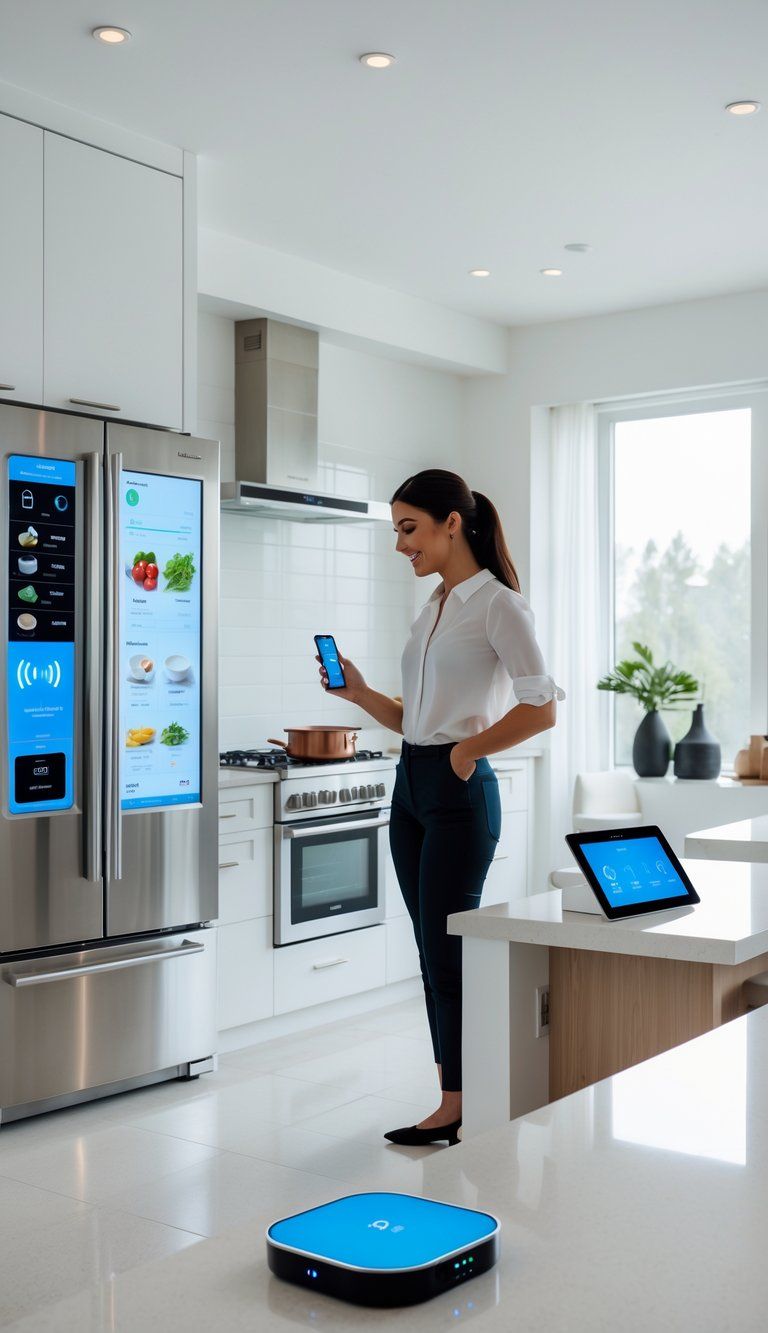
Smart appliances bring automation to everyday chores. They connect to your phone and work together to make your home life run just a little smoother.
Connected Kitchen Devices
Smart refrigerators do a lot more than just keep food cold now. Many have interior cameras, so you can peek at what’s inside while you’re at the store. That means you’re way less likely to buy duplicates by accident.
Smart ovens let you preheat or change cooking temps from your phone, even if you’re still at work. Some even suggest recipes based on what you’ve got in the fridge.
Wi-Fi coffee makers can brew your cup before you’re even out of bed. Just set it up on your phone and wake up to fresh coffee.
Smart kitchen scales and cooking assistants walk you through recipes step by step. They measure ingredients for you and handle timing, which makes things a lot easier.
Popular connected kitchen devices:
- Smart refrigerators ($1,200-3,000)
- Wi-Fi enabled ovens ($800-2,500)
- Smart coffee makers ($80-250)
- Connected cooking assistants ($100-300)
Automated Cleaning Devices
Robot vacuums have gotten a lot smarter and more efficient lately. Newer models map out your home and clean specific rooms when you tell them to. Some even empty their own dustbins, which is honestly kind of amazing.
Smart mops tackle sticky spills and wet messes. They work alongside robot vacuums, so your floors get a full clean.
Window cleaning robots stick to glass and scrub away dirt for you. If you have high windows, these things are lifesavers.
Smart dishwashers use sensors to adjust water for different loads and dirt levels. They’ll send you a ping when detergent’s low or the cycle wraps up.
Time saved with automated cleaning:
- Robot vacuums: 1-2 hours weekly
- Smart mops: 30-60 minutes weekly
- Window cleaning robots: 1-3 hours monthly
Routine Maintenance Alerts
Smart washing machines spot problems before they get serious. They’ll warn you about unbalanced loads or remind you when it’s time for maintenance.
Smart HVAC systems keep an eye on air quality and filter status. You’ll get a heads-up when it’s time to swap filters or book a service appointment.
Smart water heaters adjust temperatures based on your habits. They can spot leaks early and will even shut off to prevent water damage.
Battery-powered devices like smoke detectors ping your phone when batteries run low. No more late-night chirping waking up the whole house.
Benefits of maintenance alerts:
- Extend appliance lifespan by 15-20%
- Reduce energy costs by 8-12%
- Prevent costly emergency repairs
- Improve home safety and peace of mind
Automated Window Treatments
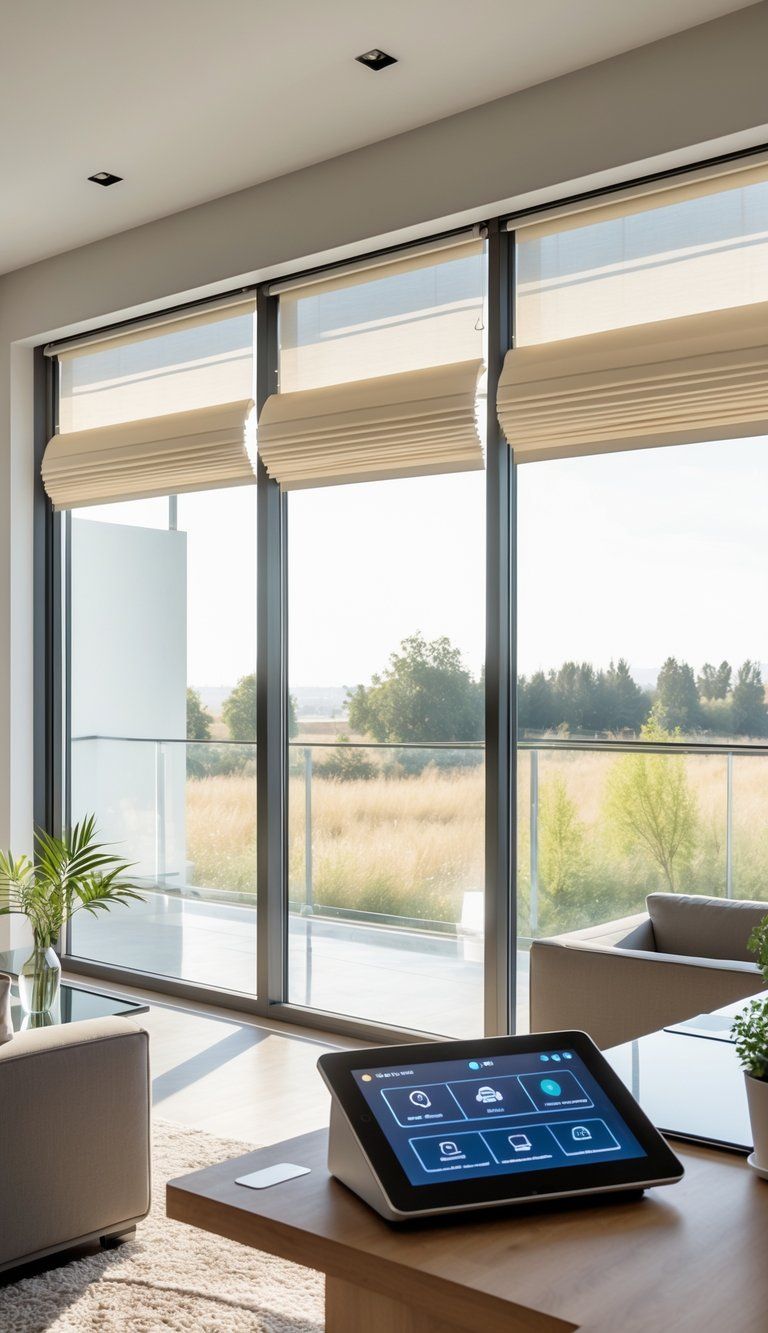
Automated window treatments have completely changed the vibe in modern homes. These smart gadgets handle your window coverings for you, making things more comfy and energy-efficient without much effort.
Natural Light Optimization
Automated blinds and shades can open and close at set times each day. You can wake up with the sunrise as your blinds quietly rise.
Many systems use light sensors to adjust your shades based on sunlight. That means less glare on your TV and less sun damage on your furniture.
You can set up custom schedules that follow the sun’s pattern all year. In summer, blinds close during the hottest hours; in winter, they open to let in warmth.
Most systems let you control everything from your phone, so you can tweak your home’s lighting from anywhere.
Climate and Privacy Control
Automated window treatments really help boost your home’s energy efficiency. Some experts say smart window coverings can cut heating costs by up to 25% by adding insulation in cold weather.
You can program blinds to close during the hottest summer hours, keeping things cooler and lowering your AC bill. A lot of people notice real savings after installing these.
Privacy features are great, too—your blinds can close automatically at sunset, so you don’t have to walk around closing everything by hand.
Basic automated window treatments start around $150-$300 per window. Premium options with more features can run $500 to $1,000+ per window. The upfront cost is a bit steep, but the convenience and energy savings often make it worth it.
Smart Plugs and Device Scheduling
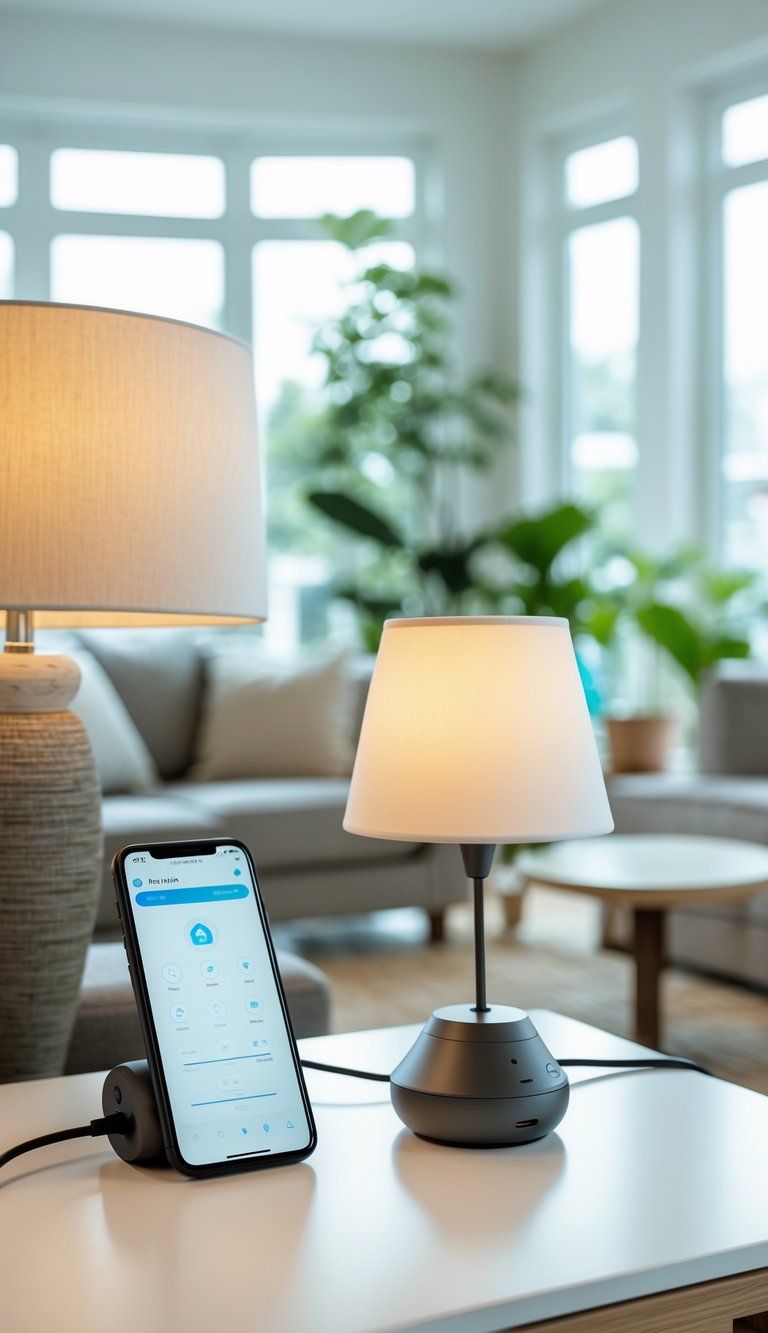
Smart plugs are a simple way to turn regular outlets into programmable, remote-controlled power sources. You can manage when devices turn on or off, track energy use, and create routines that just make life easier.
Remote Power Management
Smart plugs hook up to your WiFi, letting you control appliances from your phone. Forgot to turn off your curling iron? Open your app and shut it down—no need to stress about it all day.
You can set up routines so your coffee starts brewing at 6:30 AM before you even get up. If you’re coming home late, turn on the lights before you walk in. Most smart plugs work with Alexa or Google Home, so you can use voice commands, too.
They’re also handy for those hard-to-reach outlets behind furniture. Instead of crawling behind the couch, just tap your phone to switch off a lamp.
Energy Usage Tracking
Most smart plugs come with energy monitoring that shows you exactly how much electricity each device uses. It’s eye-opening and helps you spot energy hogs.
You can check your usage patterns and make changes. Maybe you’ll notice your TV uses more power than you thought, even when it looks off.
A lot of smart plugs let you set schedules to power down devices during peak energy hours. Some even send alerts if a device suddenly draws more power, which could mean something’s wrong.
By programming smart plugs to shut off idle gear overnight or while you’re out, you can cut your energy bill. Some folks say they save 5-15% on electricity with smart plug scheduling.
Multi-Room Audio and Entertainment
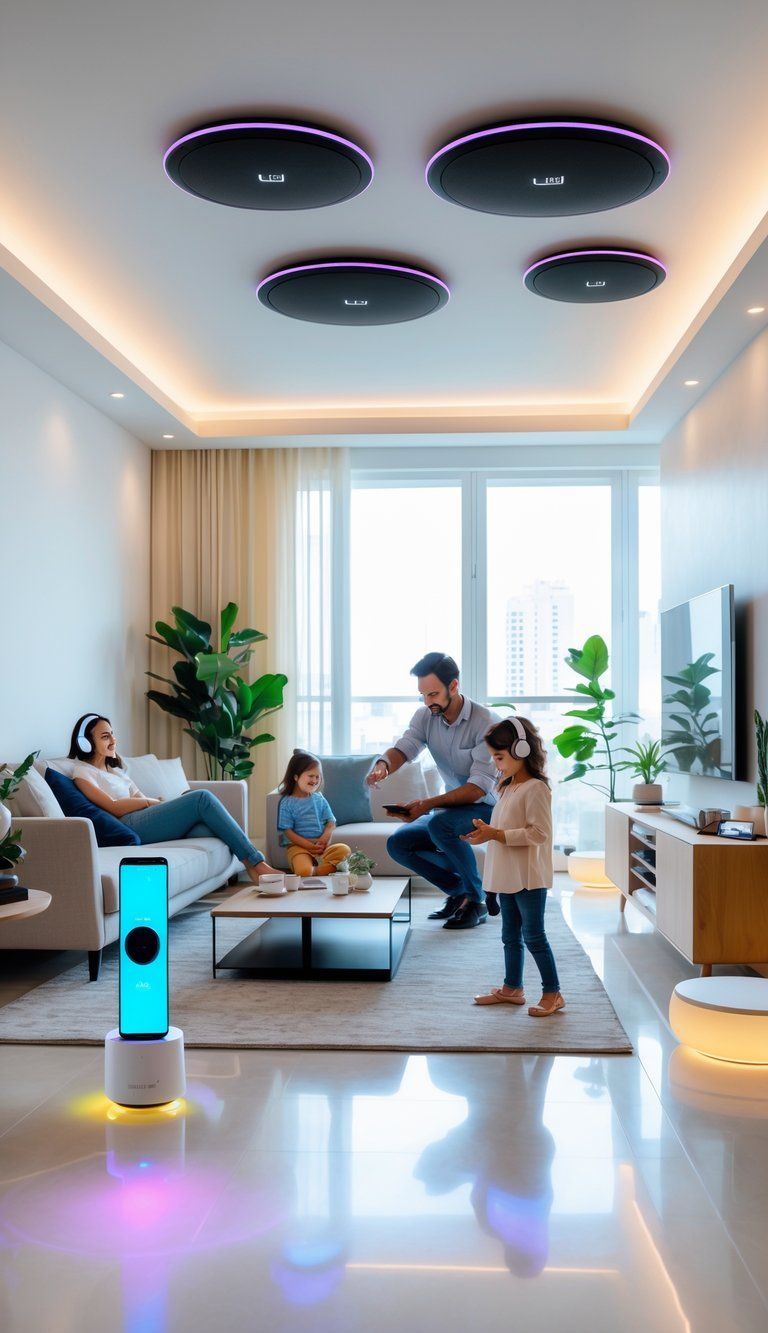
Technology has really changed how we listen to music and watch TV at home. Multi-room systems let you play music everywhere, and voice controls make managing it all feel effortless.
Unified Music Playback
Multi-room audio systems send the same music to every room or let you pick different tunes for each space. Basic setups can cost a few hundred bucks, but full-home installations can go up to $6,500.
Popular options include:
- Sonos: Great sound, three soundbars to choose from
- Bluesound: The audiophile’s pick among mainstream brands
- Audio Pro: Awesome value for the price
- Amazon Echo: Budget-friendly and integrates well
These connect wirelessly, so no messy wiring needed. You control everything from your phone—change volume, switch playlists, whatever you need.
Voice-Controlled Entertainment Systems
Voice assistants like Alexa and Google Assistant have totally changed how we interact with our entertainment setups. You just tell them what you want—music, TV, volume, you name it.
With a voice assistant, you can:
- Start music without lifting a finger
- Switch between streaming apps
- Adjust the volume
- Turn TVs and other devices on or off
- Set up routines (like “Movie Night” to dim lights and start the TV)
The Echo Show 5, for example, has a 5.5″ screen, decent audio, and controls for your smart home. Voice systems often work with other smart home gadgets, so you can manage lighting, temp, and security while you’re at it.
These systems keep getting better, with nicer sound and smoother controls rolling out every year.
Future Trends in Smart Home Features
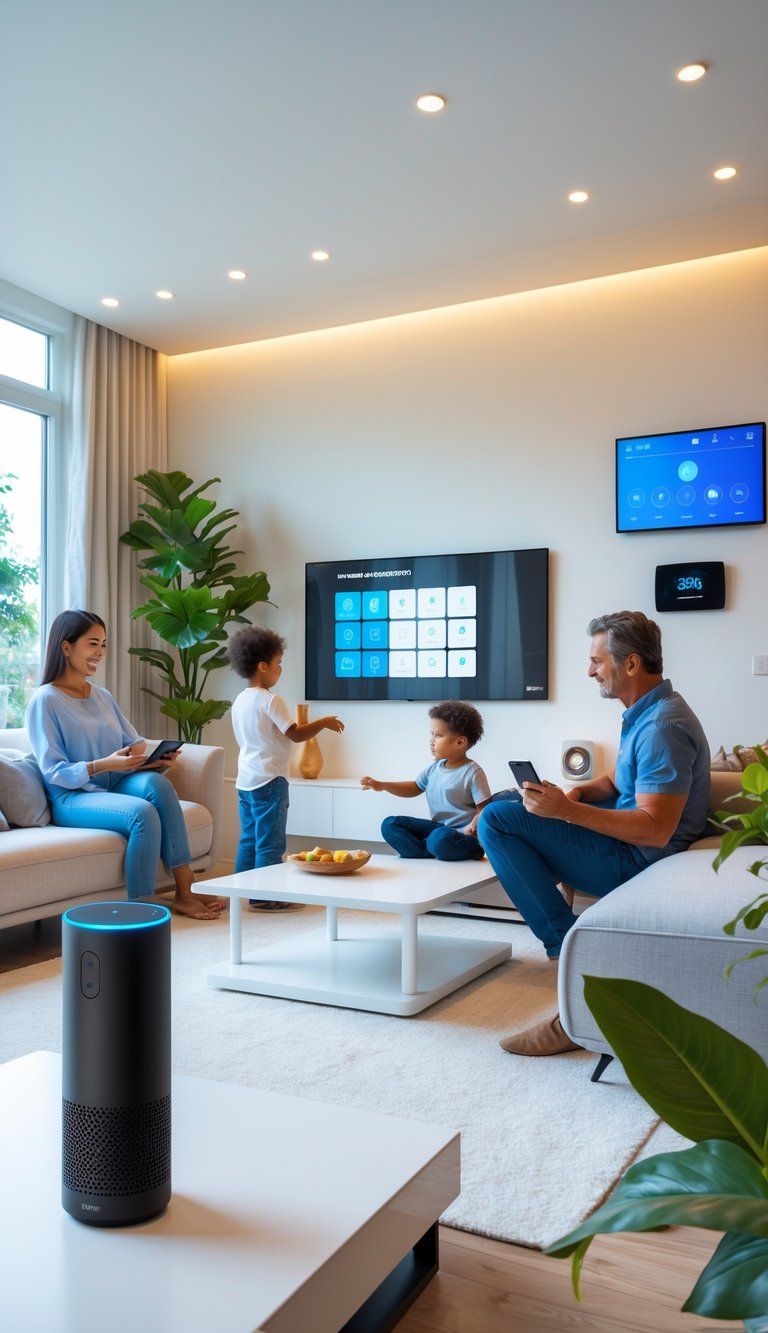
Smart home tech is evolving at breakneck speed, and honestly, it’s pretty exciting. The next wave is all about making tech blend right into your daily routines.
Advancements in Device Integration
Cross-platform compatibility is finally catching on. By 2025, major brands will use universal protocols like Matter and Thread, so your Apple, Google, and Amazon devices can play nice together.
Wireless power transmission is coming, too. Imagine your gadgets charging themselves—no more cable mess everywhere.
Voice control is getting smarter. Soon, you’ll be able to speak naturally and give multi-step instructions in one go, instead of repeating yourself.
Invisible tech is on the rise. Smart features will hide in your walls, furniture, and appliances, so you get all the benefits without visible sensors or controls messing up your home’s style.
AI-Driven Personalization
AI systems are starting to feel like real lifestyle assistants these days.
Your smart home learns your routines and adjusts on its own. Maybe it gets your coffee brewing right as you wake up, or it dials in the lighting for your evening reading—pretty convenient, honestly.
Predictive maintenance is just becoming the norm. Smart appliances can spot potential issues early, so you don’t have to deal with surprise breakdowns.
Your refrigerator might give you a heads-up about a failing part weeks before anything actually goes wrong.
Health monitoring is moving way past basic fitness trackers. Smart homes now keep an eye on air quality and sleep patterns, and sometimes they even notice changes in your habits that could signal a health concern.
AI that’s focused on privacy is finally tackling those big security worries. Some newer systems process your data right at home instead of sending it off to the cloud, so you get personalized features without risking your private info.

